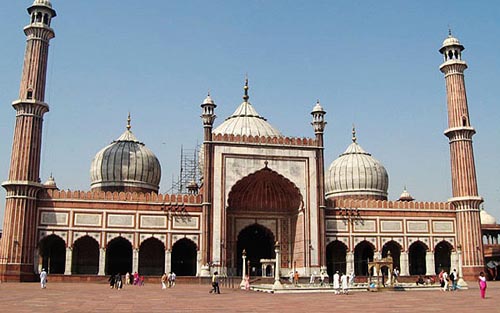Jama Masjid Delhi

Information on Jama Masjid (New Delhi) - History & Architecture
Jama Masjid is originally known as Masjid-i Jahan-Numa in Urdu. The Jama Masjid is situated in Delhi and is revered as the major mosque of Old Delhi in the country. The mosque was built on the orders of Shah Jahan, the Mughal Emperor and is considered to be quite well-known in India. The work related to its erection commenced in the year 1650 and ended in the year 1656. It is located at the starting point of Chawri Bazar Road in Old Delhi and is supposed to be a central street buzzing with continuous activities. The name Jama Masjid was given afterwards and relates to the prayers of the Muslim worshippers on weekly Friday midday also known as Jummah. The mentioned ritual of weekly Friday praying is generally performed in a particular mosque or "Jama Masjid". It is believed that the patio of the Jama Masjid is capable of accommodating around twenty-five thousand worshippers. The mosque is known to possess numerous artefacts which are stored in a wardrobe near the gate on the northern side, and comprises a historic facsimile of the Quran printed on deer skin.
Jama Masjid Delhi Architectural Significance
The construction of the mosque was intended in a way so as to make it one of the largest and popular mosques throughout the country. The groundwork related to the historic mosque, Jama Masjid was initiated on a small hill in Shahjanabad by Shah Jahan on 19th October, 1650 AD. The grand mosque was the end result of more than 6,000 workers and their endeavours. The complete construction work of the mosque took a period of six years and above. The erection work of the mosque engaged a sum of INR 1 million during those times. The other mosques that are the Red Fort in Delhi and the Taj Mahal in Agra were also erected by the same emperor, Shah Jahan and the Red Fort is located just opposite to the mosque. The work of Jama Masjid ended in the year 1656 AD and includes four towers, three huge gates and two minarets with a height of 40 metres each which were made from white marble and red sandstone strips. The design of Jama Masjid reflects a merge of both Indian as well as Mughal pattern of architecture.
Jama Masjid Delhi Historical Significance
The mosque is capable of being noticed from any part inside the ambit of 5 kilometre area as the mosque was constructed on a position higher on the ground in contrast to the other additional structures in that particular area. The architectural pattern of a different mosque in Lahore constructed by one of the sons of Shah Jahan is also found to be alike to the style of Jama Masjid. Colossal use of red stone was put into use which constructing Jama Masjid in order to aid it keep standing throughout the seasons. The mosque has a chamber in the west which is basically a big hall area which is founded on 260 numbers of pillars, all of which are imprinted in accordance with the Jain and Hindu customs. The entry point on the east side of the mosque, shows the way to a different enclosed space which houses the burial place of Sultan Ahmed Shah. The mosque witnessed two explosions inside its complex on 14th April, 2006 which left 13 people injured. Another act of terrorism took place on 15th September in the year 2010 when gunmen fired bullets openly on a bus which was parked near the third gate leaving injured two Taiwanese visitors.
Jama Masjid Delhi Tourism Significance
The historic significance of the mosque and the grandeur of the structure makes it a magnificent and existent instance of great Mughal architecture thus, including it in the must see list of the tourists visiting India from across the globe.